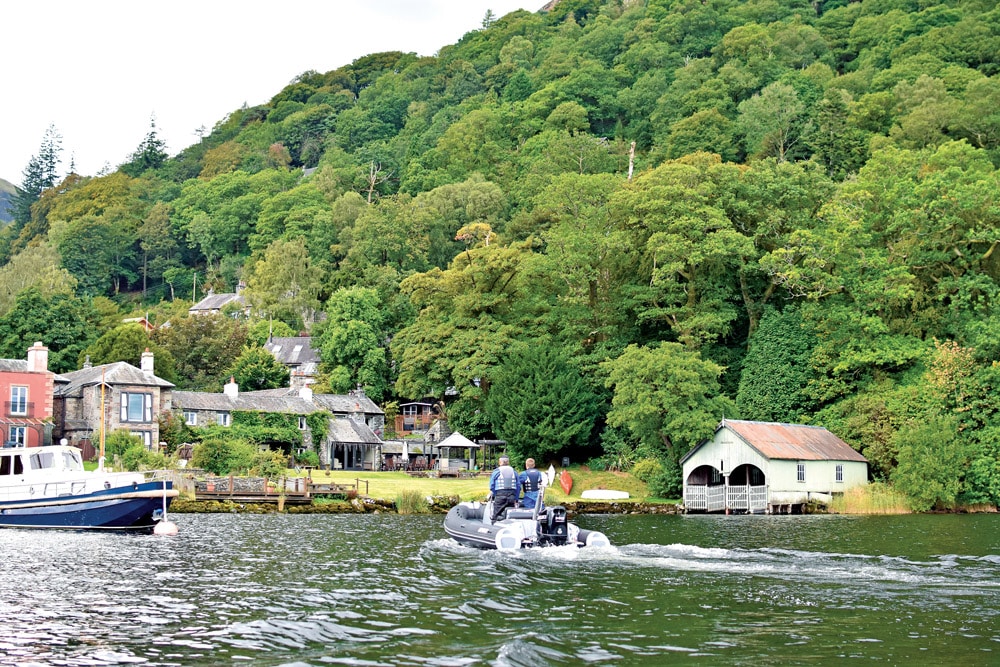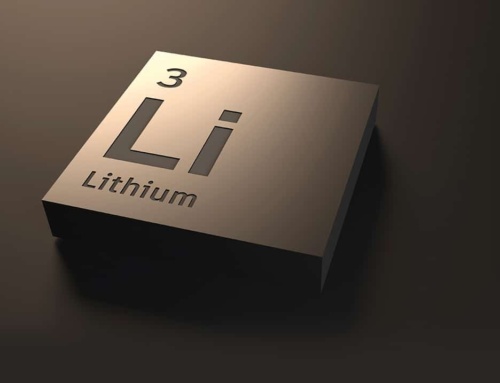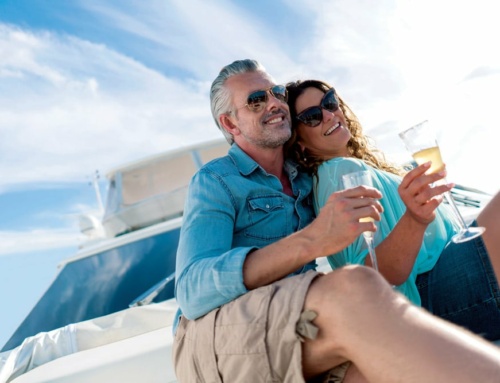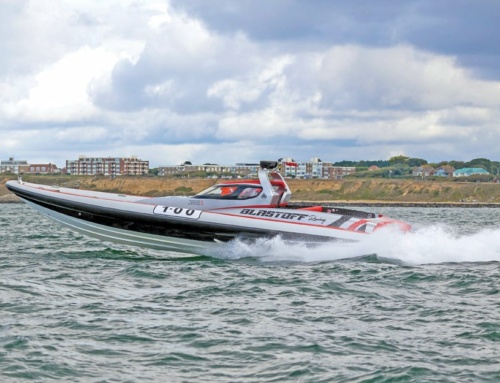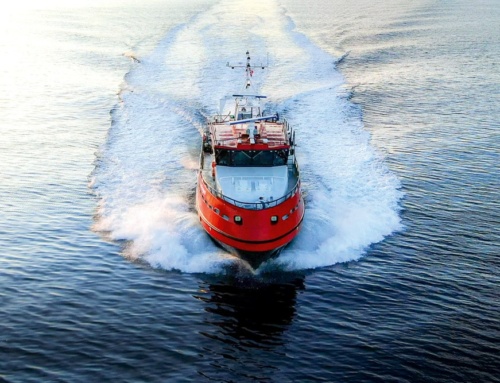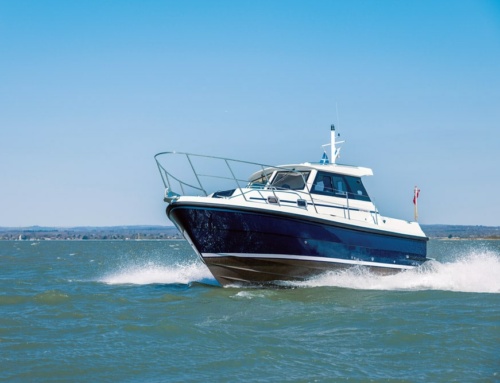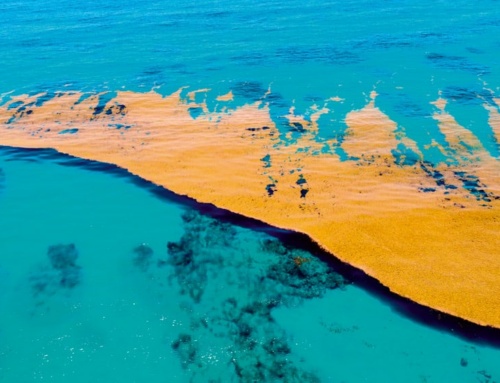We join Jonathan and Tom Peers on a grand tour of the Cumbria Lake District as they set about discovering the delights of freshwater adventuring aboard three very different modes of ‘waterborne transport’.
It’s sometimes said that ‘it’s grim up north’, but travel far enough and you reach Cumbria. Five hundred million years of savage geological processes have shaped this county into an area of true outstanding natural beauty blessed by ascending mountains and dark lakes, rich forests, and green valleys adorned by stone cottages and remote farms. Anything but grim!
The valleys formed by this dramatic mountainous landscape are able to hold colossal amounts of fresh water. Heavy rainfall in this region maintains the water levels of 14 lakes and tarns, giving this unique region its name – the Lake District.
The vast majority of my boating is done at sea, chiefly off the coast of Anglesey, so when the assignment came from PBR for my son Tom and I to spend a few days exploring the Lakes aboard a selection of craft supplied by The Wolf Rock Boat Company, we leapt at the chance to go freshwater adventuring.
Windermere: The adventure begins
Windermere, well known and much loved, is arguably the most popular destination for those seeking their first taste of what these mountain waterways have to offer. It’s also where our adventure got underway. Our host and local guide Richard Rothwell, of Bowness-based Windermere Boat Sales, was the man responsible for helping to supply and coordinate the craft being made available to us.
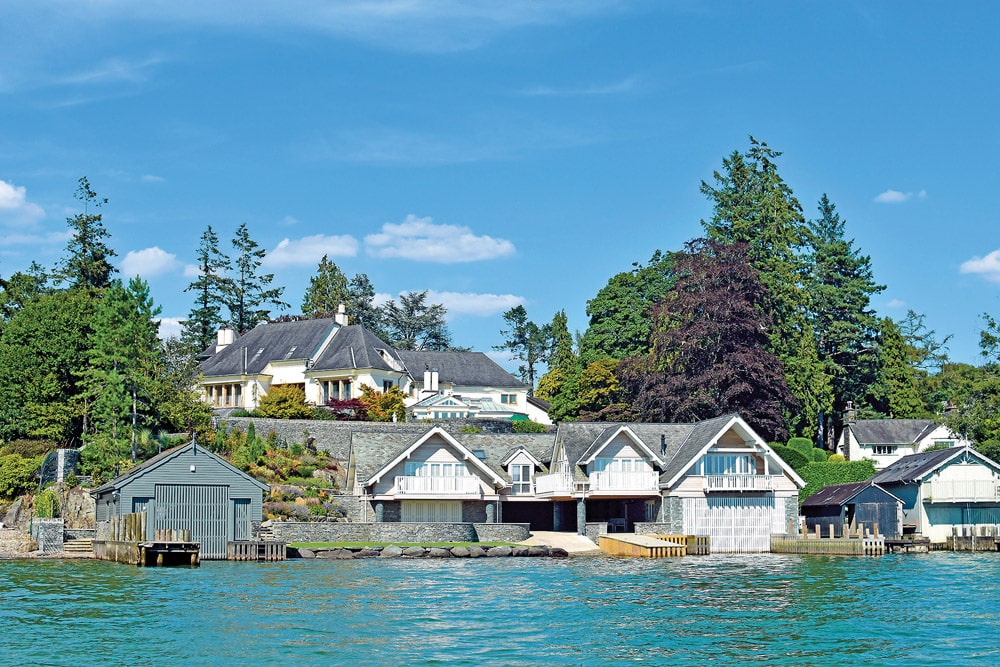
Modern or traditional, boat houses are a common feature on Windermere.
The little town of Bowness is situated about halfway up the eastern shore of Windermere. Its narrow streets and the architecture of its tall buildings, while feeling almost claustrophobic as they seek to gain every last inch of the town’s limited footprint, nonetheless immerse the senses in Cumbrian charm. As a visitor you will find everything you need within walking distance of the town’s main car park – attractive shops and hotels, pubs and guest houses, and there’s no shortage of places to eat either! Fans of Peter Rabbit can visit the Beatrix Potter Experience, while those who prefer the works of Charles Dickens may feel compelled to visit his old haunt and enjoy a pint in the Hole in t’ Wall public house, tucked away as it is in one of the many narrow streets just a stone’s throw from the lake.
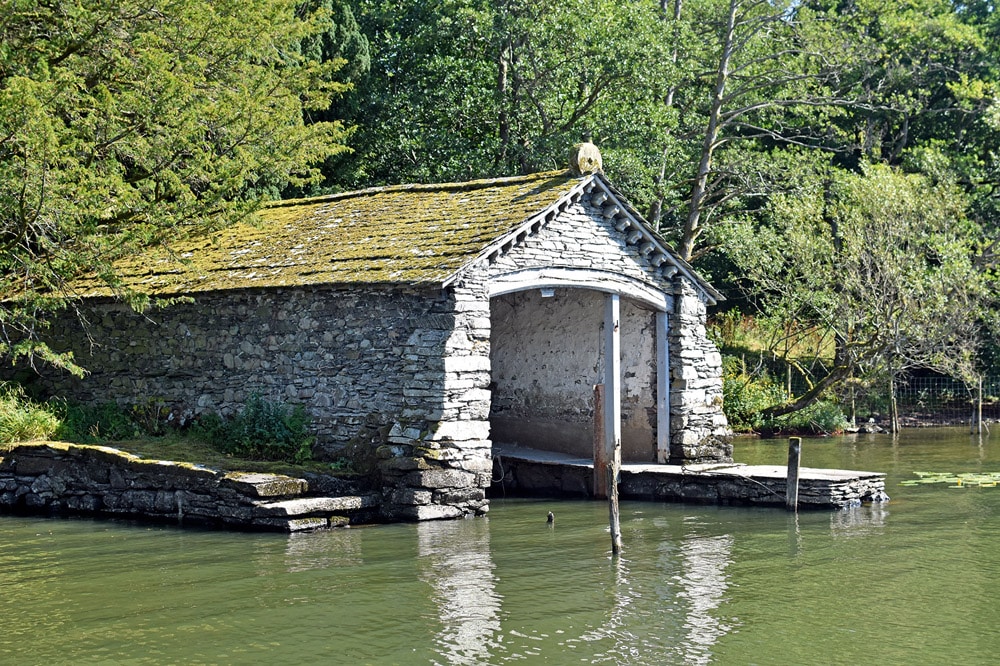
Modern or traditional, boat houses are a common feature on Windermere.
Wandering around Bowness before the town had fully awoken on a bright, sunny Saturday morning allowed us to witness the delightful buzz of activity of a community rising from its slumber in preparation for the day’s influx of visitors – all eager to enjoy what the town and its shoreside have to offer. It wasn’t long before the tour boats were beginning to fill too, and the little fleets of colourful self-hire boats were entertaining queues of eager people all wanting to get out on the water.
Heading back in the direction of the marina, we were greeted by Richard, whose premises looks out over a panorama of moored boats, plus its own impressive row of wooden jetties, each adorned with an eclectic mix of craft. Here we were shown to our steed for the day: a Smartwave 4200, powered by a Suzuki 40hp outboard engine. Armed with just a pamphlet map of the lake (no Admiralty Charts here!), and following the benefit of a briefing from Richard on suggested places to explore as well as the red-buoyed hazards to avoid, Tom and I loaded our kit, familiarised ourselves with the boat and cast off.
Windermere facts
- Bassenthwaite is the only ‘lake’ in the Lake District, the rest are either a ‘mere’ or a ‘water’.
- At around 11 miles long and covering an area of 5.69 sq. miles, Windermere is the largest body of water.
- Windermere froze over in 1895, allowing people to walk from one side to the other.
- In 1930, Henry Seagrave took to Windermere to break the world water speed record aboard Miss England II.
- Windermere hosts an annual stone-skimming contest.
10 knots, no more
Incredibly for a lake with a 10-knot speed limit, just leaving the dock proved a hair-raising task in itself. Off to our right, where the tour boats were operating, skippers clearly were at pains to ensure their close-quarter manoeuvring cost them no unnecessary time, as their approach speed appeared to virtually match their cruising speed! Added to this, dozens of first-time boaters were buzzing about like bees, merrily zipping around in every direction, seemingly without any destination in mind! But after having negotiated a safe but somewhat fraught course through the mayhem, it wasn’t long before we’d fled the madding crowd and found ourselves amid the tranquillity and serenity of the lake.
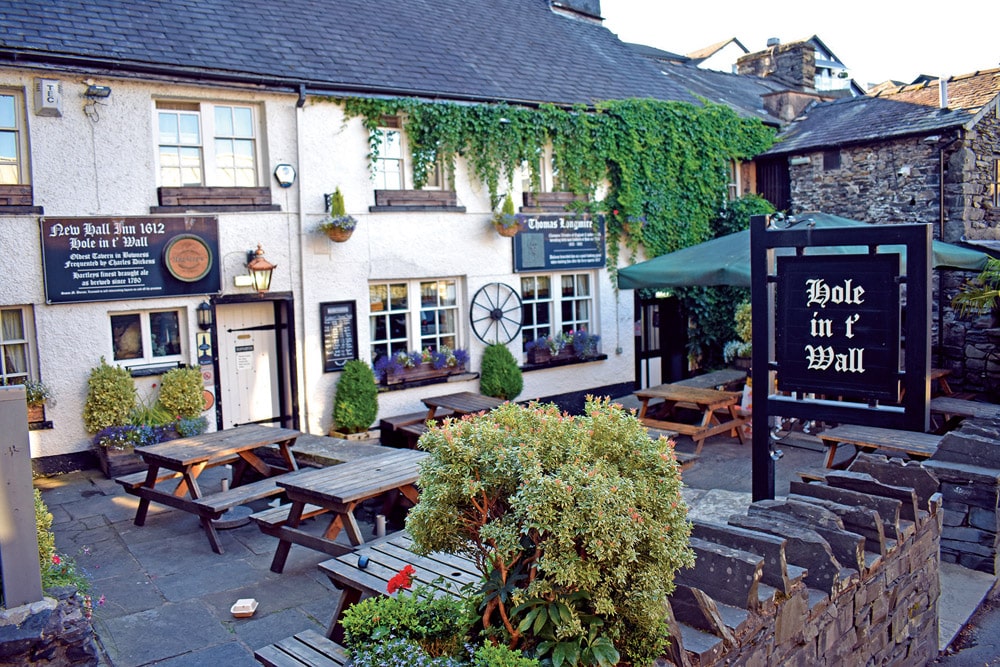
The famous Hole In’t Wall public house, as frequented by Charles Dickens
With Tom at the helm, trying to be as conscientious as possible as regards the mandatory speed limit, I found myself quite content to sit up in the bow simply watching the world go by. This sedate pace was a far cry from our usual antics on the Irish Sea. As we headed north up the lake, I confess we felt more like tourists than adventurers! But along the way, we took pleasure in hoving-to to admire the various anchorages and the many private boathouses dotted along the shore. It’s worth noting that most of the shoreline is privately owned, meaning that you can’t just beach your boat and go ashore. Houses and hotels in choice positions along the lake offer their occupants idyllic views of the water and surrounding countryside, but likewise, many of the jetties you see here are privately owned by these properties too.
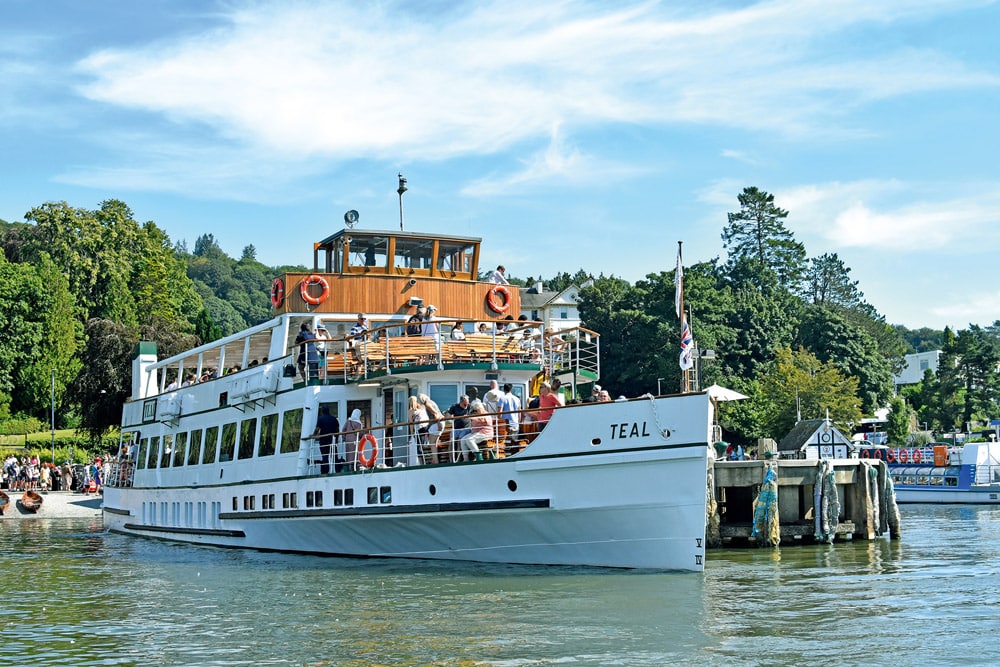
The 1936 design of Teal suits the surroundings perfectly
Clubbing on Windermere
With popular club sites already well established at Hythe and Portsmouth, Freedom Boat Club UK have recently launched their first franchise, located amid the beautiful scenery of Lake Windermere. The new Windermere club opened its doors on 1st September 2022 at the self-contained and well-equipped Aquatic Quays Marina. A stunning location boasting district status as a World Heritage Site, both established and new members can now enjoy access to the ultimate Lake District experience. Operating with an impressive fleet, miles of water to explore and a professional team on hand to guide and support, this is a prime opportunity for boating enthusiasts to discover the many delights of this region.
Website: www.freedomboatclub.co.uk
The head of the lake
As we coursed our way along through the still waters, we were joined by the motor vessel Teal, a magnificent passenger boat that plies the full length of Windermere. Her 1930s styling set against the utterly striking backdrop of the Lake District National Park evoked a timeless image and thoughts of simpler times associated with a generation long since passed. We gazed on, and as we admired, I couldn’t help but wonder just how a 142ft boat, weighing some 251 tonnes, found its way onto a landlocked lake! After making some enquiries, we discovered that Teal was constructed by Vickers of Barrow in 1936, and then transported in sections by rail, before being assembled on the lake. No wonder she hasn’t been replaced!
We eventually reached the head of the lake, hemmed in on either side by the surrounding Cumbrian landscape. It was a strange feeling and it emphasised the contrast between inland and coastal, where the latter rarely, if ever, offers anything but freedom. But here, upon the waters of Windermere, we came to appreciate for the first time the finite nature of lake-borne boating.
As we gently floated off the aptly named Waterhead, near Ambleside, we came across a landing stage for the tour boats as well as a number of wooden jetties, two of which are set aside for public use. Here, boats could disembark and take advantage of the facilities ashore. But with plenty of fuel still in our tank, we decided to continue with our mission to complete a lap of the lake southbound. Pointing our bows southward, we started out along the western shore.
The western shore
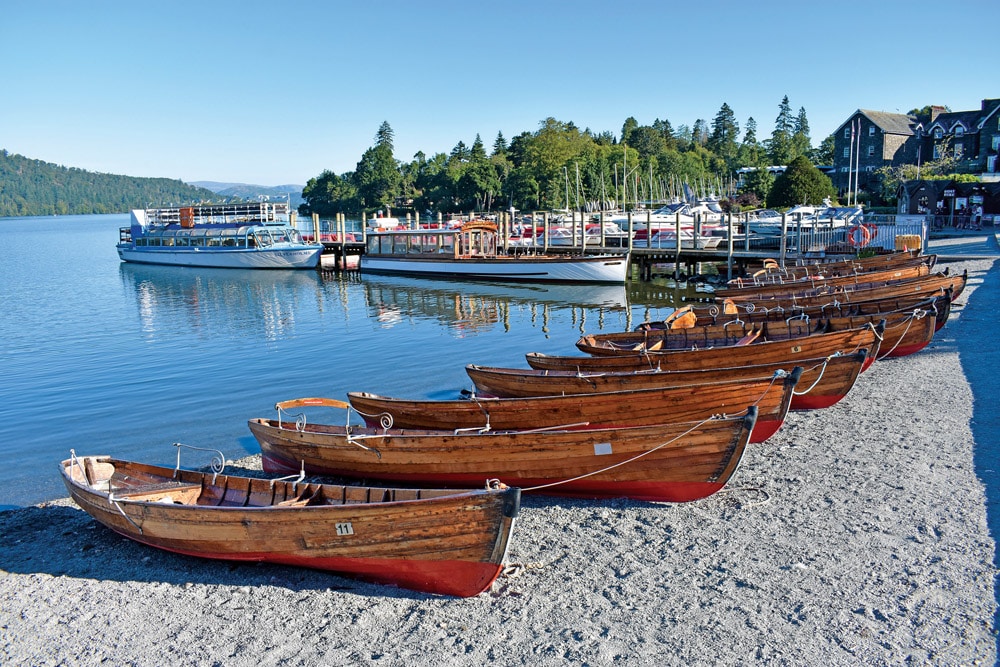
Traditional rowing boats available for hire at Bowness-on-Windermere
Tucked away in a bay, as if it were a scene from an old postcard, was a handsome, period, lake-front house identified by tall chimneys. Before it, three large luxury cruisers sat rafted abreast of each other at anchor. Then, breaking the calm, sped a boy on a small inflatable tender propelled by a little 3.5hp motor. The young lad was clearly having the time of his life, and I’m sure he was having much more fun than the grown-ups aboard their big boats. It reminded me that boat size alone rarely correlates to the degree of fun that can be had afloat.
Apparently, the Lake District is now the ‘go-to destination’ for wakesurfing. Wake boats, with their electronically controlled trim tabs and intuitive automated systems, are able to both create and modify large wakes on which riders can surf at relatively low speeds. Such technology has allowed water sports to thrive in environments where many people never thought it possible due to environmental and local authority restrictions. Like ’em or loathe ’em, wake boats are a part of the culture that exist on 21st-century Windermere.
Passing our starting point of Bowness, we continued on past Ferry Nab. The latter is a preferred launch and recovery location. From here, a chain ferry also operates, carrying cars and foot passengers to the opposite shore. But caution dictates that the ferry chain should be respected at all times when boating in this vicinity.
Upon reaching the southern end of the lake, we arrived at Lakeside. Here again there is a landing stage for the tour boats, but what did catch my attention was the Lakeside Hotel. This fine-looking establishment has at its disposal a number of jetties specifically set aside for visiting craft. It was at this point I began to appreciate the lake boating ethos. Life on the lake is about soaking up the timeless environment, the bustling activities both ashore and afloat, and the captivating sights to be admired with every mile covered. While the towns and villages offer their own overnighting attractions, so does the option of sleeping aboard. Indeed, Windermere appears to have much to offer those wishing to weekend aboard their boats.
With the sun now lying low in the sky, our first day came to a close. The delightful little Smartwave – a boat Tom and I genuinely enjoyed – had proved itself to be the perfect lake-going companion. Over the course of our day’s voyaging, we’d burned less than 20 litres of fuel – frugal by anyone’s standards – and if accompanied by such simple pleasures as a few home-made sandwiches and a flask of tea, then such a day’s motoring afloat probably doesn’t get any cheaper!
Smartwave 4200

Being built from rotationally moulded plastic, it struck me how well suited our Smartwave was to this freshwater environment. Out here, it’s not uncommon to come across the odd flowing tree branch, and of course, when wanting to push into the shallows or beach the craft, where the likes of GRP could be subject to damage, the Smartwave’s construction benefits from being virtually indestructible. Plastic boats, although somewhat utilitarian, have proven themselves all over the world in a variety of roles, from workboats to sailing club support craft. The beauty of these boats too is that they can be produced in a whole variety of colours. For use on the lake, white or maybe green I’d consider to be the most visually sympathetic options.
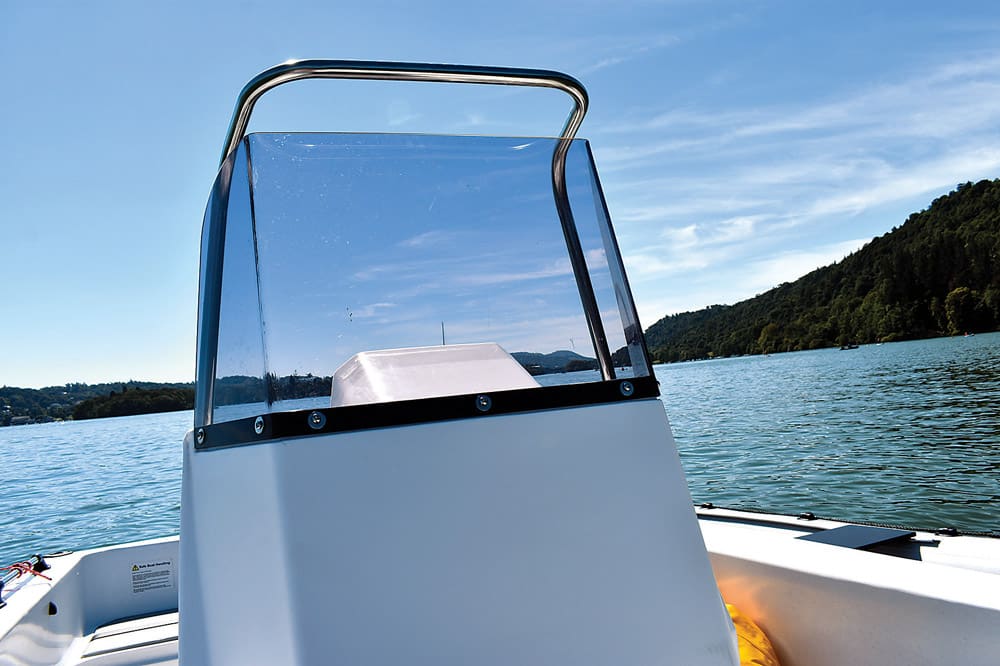
Screen-top grab handle provides an element of confidence to the Smartwave when walking around the console.
The Smartwave’s helm position takes the form of a stand-alone centre console, with a deck-mounted cool box doubling as the helm seat. While driving, the controls are positioned such that being seated or standing is equally comfortable. However, the cool box requires a more secure means of attachment to the deck. The bungee cords, which form the current means of securing this item to the deck, really are not sufficient.
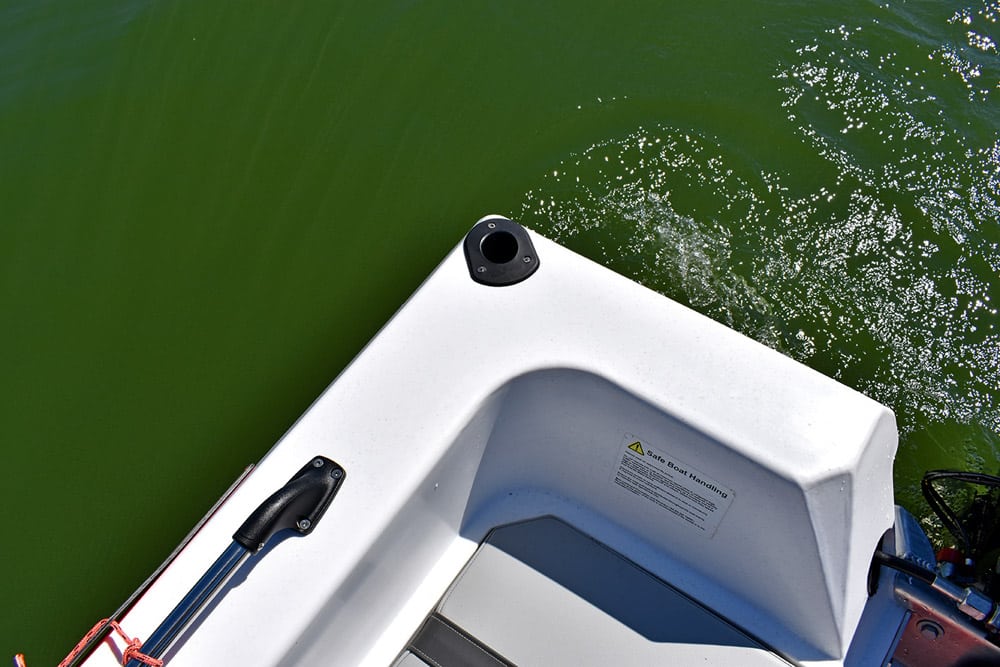
Rod holders are well positioned but the lack of rear cleats is disappointing.
The console has ample room for mounting a basic electronics package, while the open locker below is big enough for one day’s supplies, including food, spare clothing and camera gear. Surrounding the generously sized windscreen is a sturdy, well-placed stainless handrail – perfect for when needing to access the bow. Remarkably, despite this boat’s small size, its broad beam means that the deck is of true walk-around design.
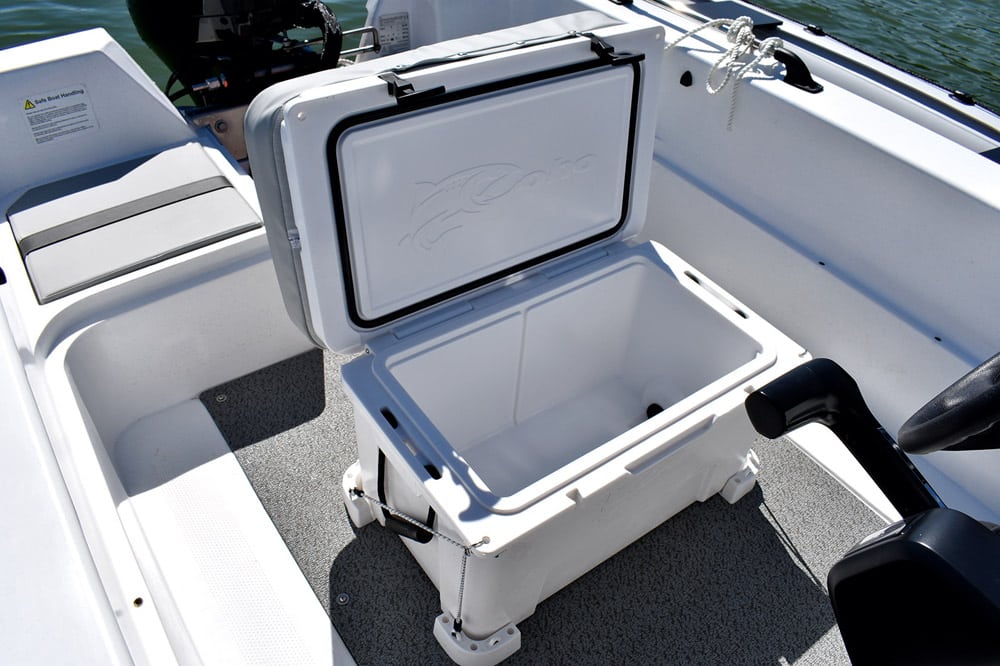
A sealed coolbox forms the helms seat. Although nifty, being secured with bungee cords means the box will tip when leant against.
Both fore and aft, you’ll find basic upholstered seating that conceals various storage compartments. These are handy for stowing fenders, lines and fishing tackle, as well as vital items of kit such as an anchor and flares. My only other criticism of the fit-out is the lack of rear-mounted cleats, which made tying up and the business of securing the boat difficult. As for the Suzuki 40hp outboard, this, in our view, is an ideal choice of engine size and power output.
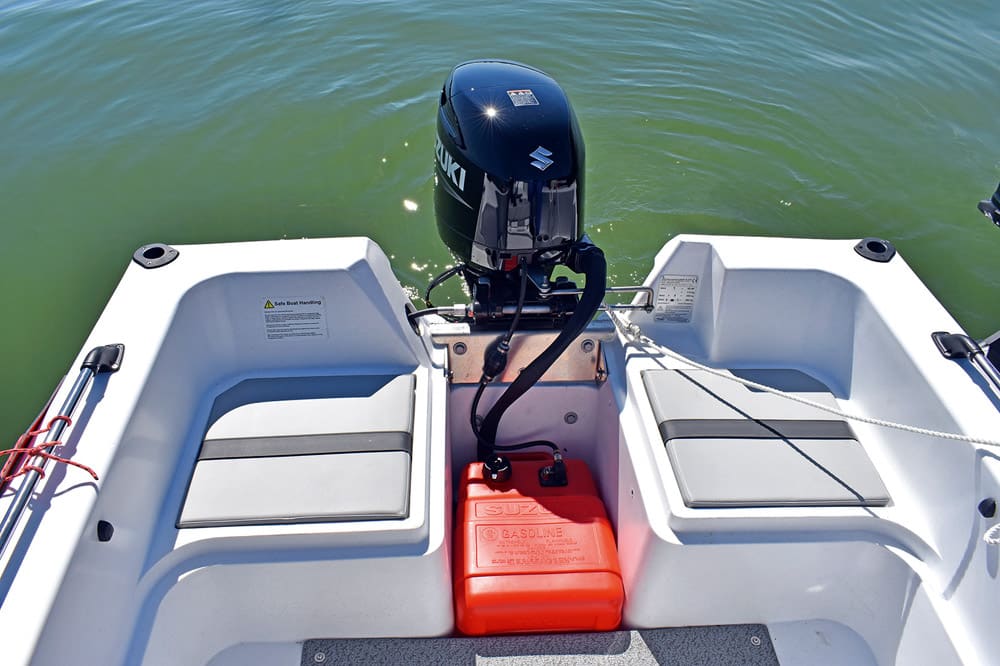
Although basic, the uncluttered cockpit offers spacious seating.
Ullswater: Wordsworth country
The following day we headed further north, to Ullswater. In true Cumbrian style, the blue skies and sunshine had been replaced with grey cloud, though thankfully no wind or rain to dampen our spirits.
We arranged to meet up once again with Richard from Windermere Boat Sales, who for this day’s adventure provided us with a 6m Brig Eagle RIB. Adorned with black fabric impression tubes and a sleek stainless steel towing post, this RIB looked the part.
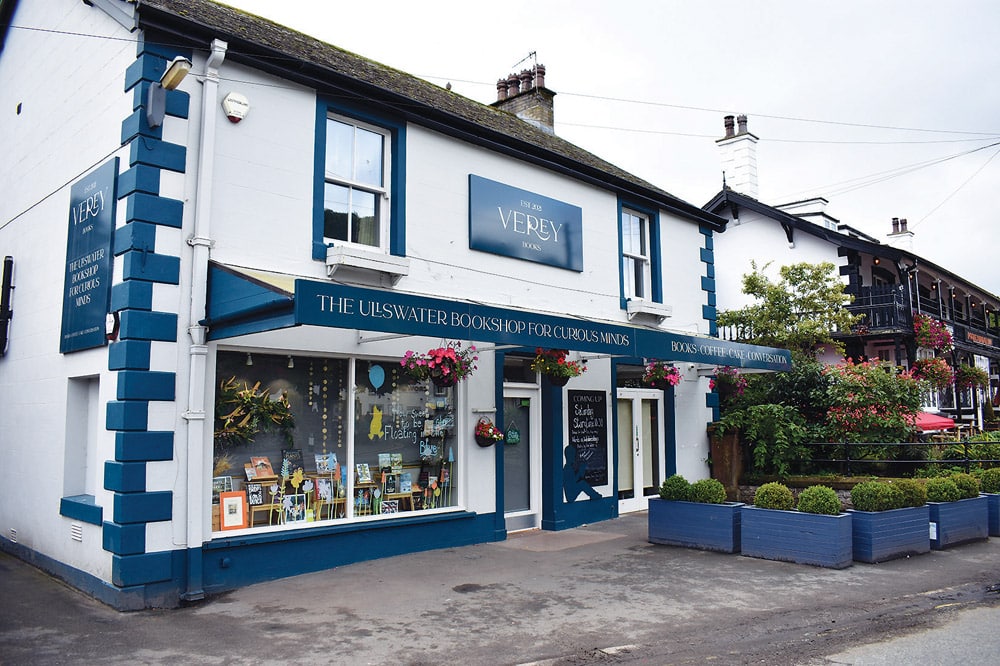
Pooley Bridge.
Visiting craft are best heading for Park Foot Holiday Park at Pooley Bridge, located at the lake’s northernmost end. Here you can launch and park your car and trailer for the modest sum of £10. This was our departure point and as conveniently a situated launch pad as anywhere you’ll find in these parts.
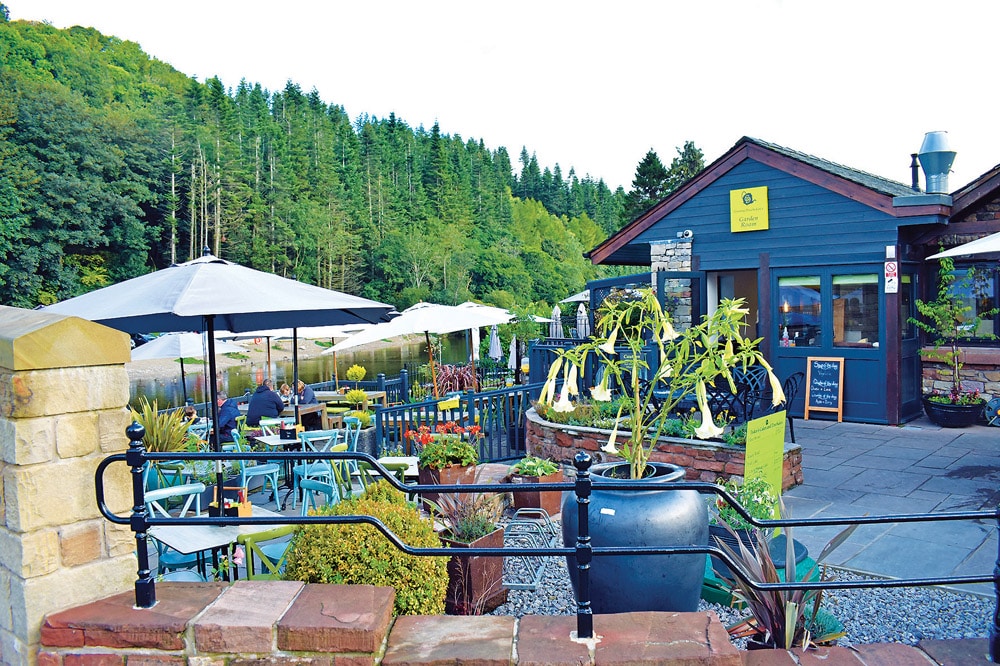
Pooley Bridge at the northern end of the lake.
Having already walked around Pooley Bridge, it was clear that this village, although incredibly popular, was not the tourist hotspot Windermere has become. Despite the lack of ‘buzz’ in the air, there was still plenty on offer for visitors, though – from gift shops and public amenities to a healthy number of places to eat. One such place was serving breakfast to diners as they sat outside in the shadow of the bridge from which the village takes its name.
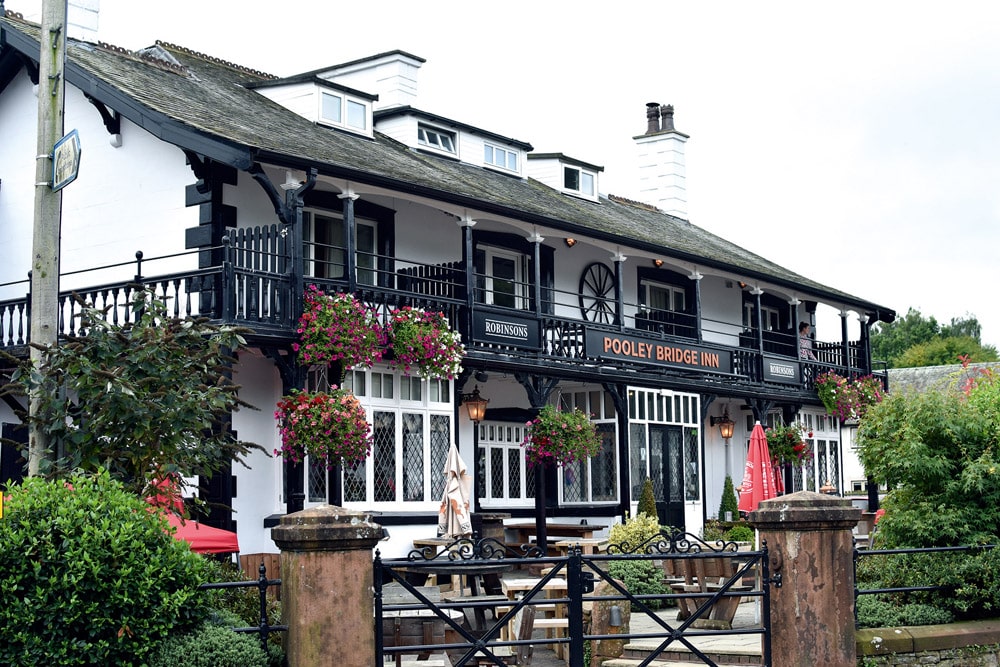
No shortage of places to eat or drink in Pooley Bridge.
Upon heading out onto the water, it’s clear to see why Ullswater is so favoured by the paddle sports and sailing fraternities. That’s not to say powerboats are not welcome. Once again, we were governed by a 10-knot speed limit, enforced by the rangers who patrol the lake. Refreshingly, however, we didn’t have to have any form of registration.
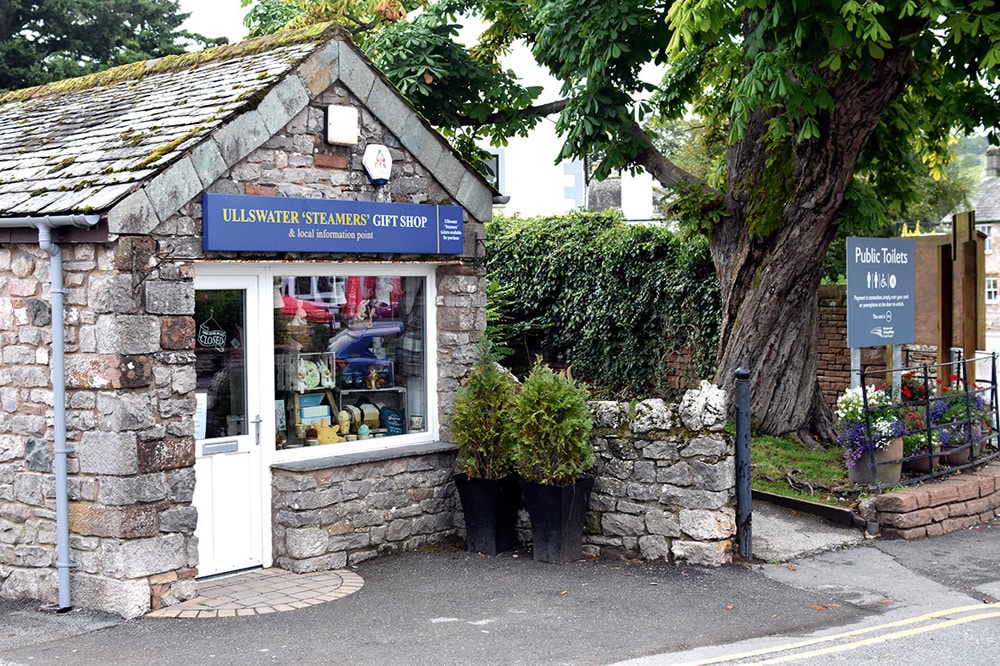
Gift shops and public toilets.
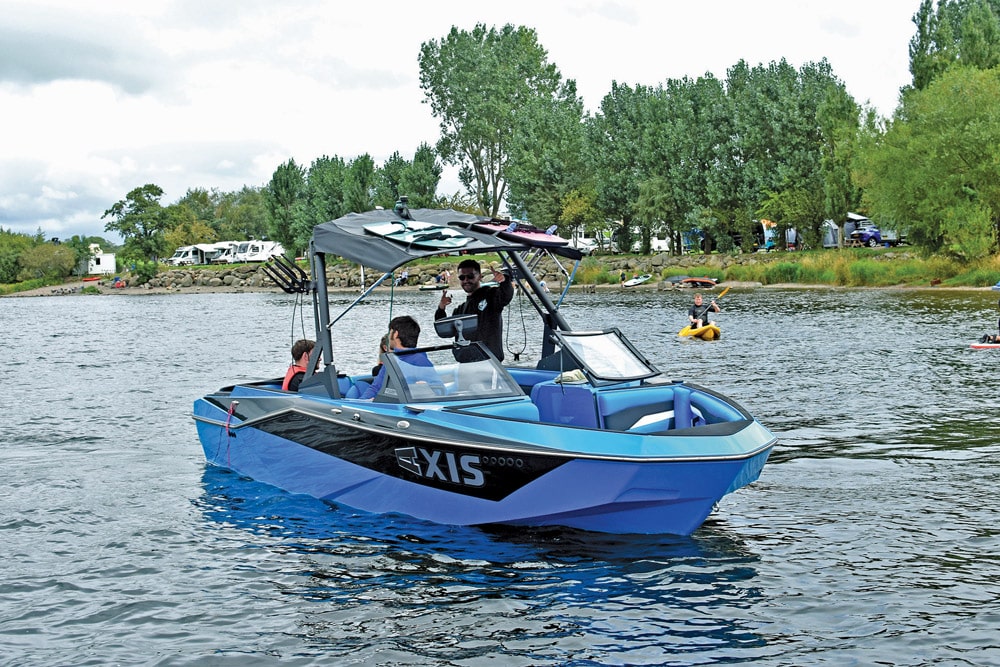
Ullswater boasts its own wake surfing school.
Anticlockwise
Opting for an anticlockwise route around the lake, we headed for the far shore. Another benefit of Ullswater is that there appear to be very few underwater hazards, as long as one remains mindful of maintaining a reasonable distance from the shoreline.
As with Windermere, there are a number of lakeside properties and some wonderful boathouses dotted about too. For me, Ullswater is a lake of two parts. The northern section is surrounded by relatively flat, open areas, and in this regard it is relatively featureless. As we reached the lake’s ‘dog-leg’ at Howtown to take a more westerly course, the scenery closed in upon us. There’s a sense of the Norwegian fjord about this place. Its towering mountain terrain and craggy peaks, shrouded as they were on this day in sullen cloud, are humbling. This ‘pinch point’, as we were to discover, was to set the tone for the second, lower section of the lake.
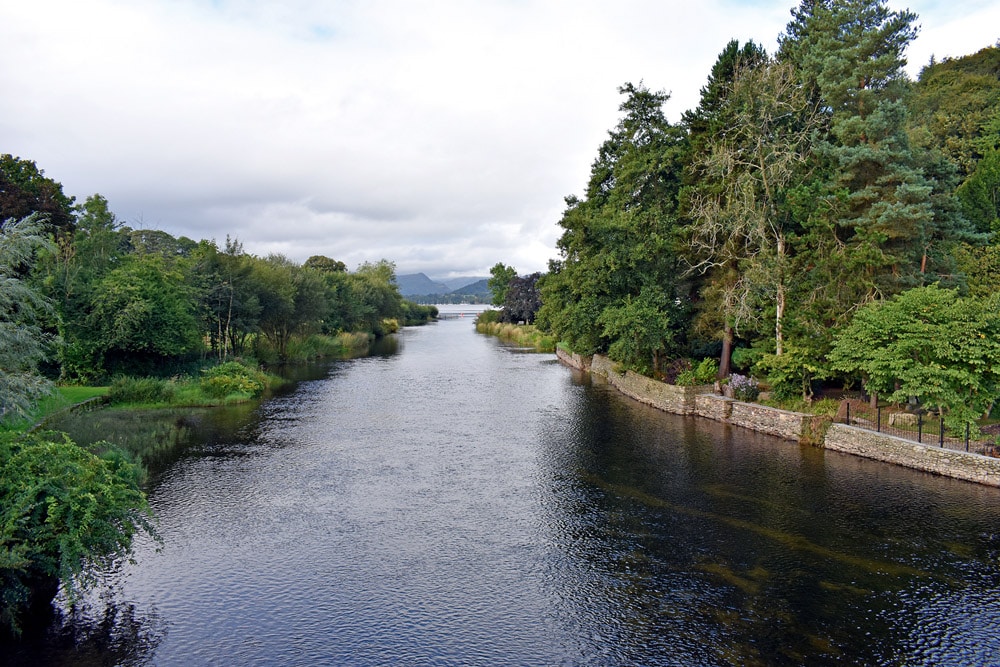
The River Eamont is fed from Ullswater at Pooley Bridge.
With no obvious waterside restaurants or cafes along our route, we saw a few boats that had been beached while their occupants enjoyed a lunchtime barbecue ashore. We, however, weren’t so well prepared and hence had to make do with a peppered steak slice and a bag of crisps!
Isles of the lake
Approaching Glenridding, we passed the delightfully picturesque Norfolk Island. Like something from a child’s storybook, this rocky isle, topped with trees and vegetation, called out to be explored. Sadly, we would have to wait for another day and another opportunity, as we were particularly fearful of risking a showroom boat on Norfolk’s rocky shallows.
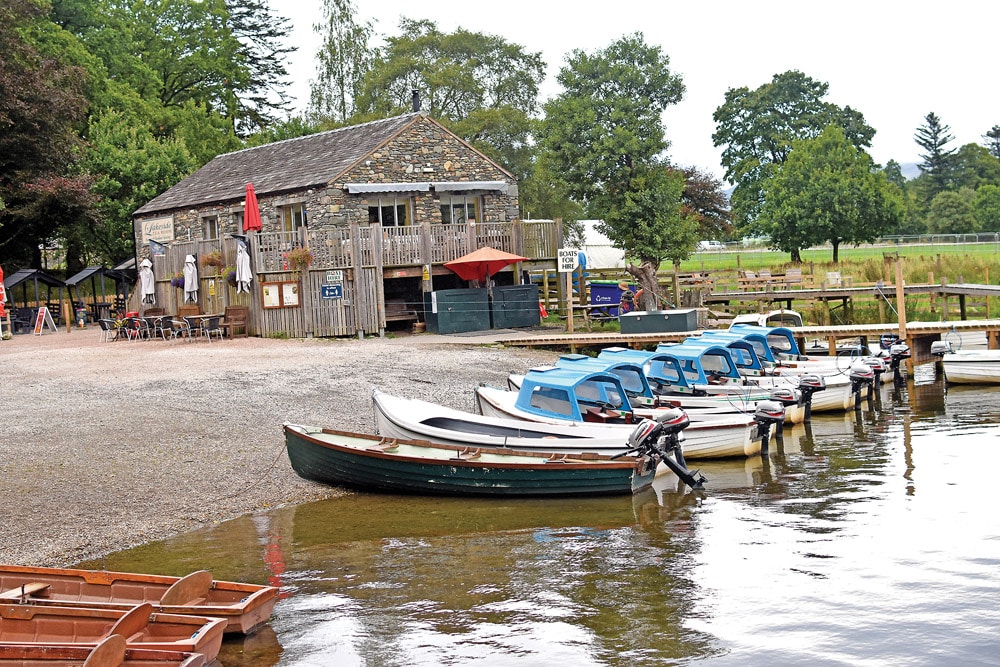
Glenridding is a tranquil place tucked away at the southern end of Ullswater.
As we passed by several other small islands and rocky outcrops, we found ourselves being overtaken by one of the several passenger steamers that traverse Ullswater. She appeared to have issued from Glenridding, an attractive place that sits on the fringes of a tranquil, sheltered basin. A sizeable landing stage here accommodates the lake’s tour boats and steamers, and for those of a certain constitution, wild-water swimmers can take to the water from the nearby stony beaches located a short distance away.
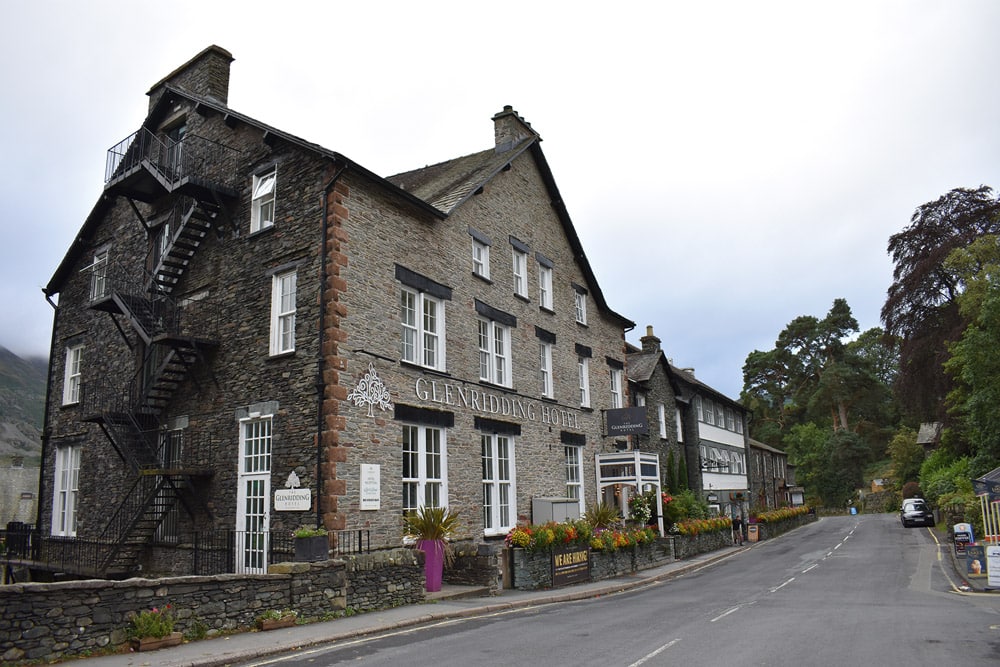
Glenridding Hotel.
Before long, a small fleet of hire boats began to join the mix of activity. We learned that they’d hailed from St Patrick’s Landing, one of the most beautiful little boatyards I think I’ve ever seen. The Lakeside Tea Room is also located here and serves as a handy watering hole for those visiting Glenridding either by foot or from the water. But should you wish to walk into Glenridding itself, you’ll find a good selection of local shops and overnight accommodation, and a good choice of hostelries and places to eat.
Burbling along, I quite forget that we were, in fact, aboard a very capable 6m RIB. Not only that, but there was a Suzuki DF140 bolted to this baby’s tail! A bit overkill perhaps for a 10-knot speed limit waterway, but it was impressive nonetheless that the fly-by-wire controls allowed us to fine-tune our speed with such ease while the Brig’s vee-hull maintained, even at this pace, a planing attitude. With a walk-around double console and rear bench seat, I could clearly see the appeal of owning a Brig 6m Navigator as a capable, general-purpose family boat. The boat was really well spec’d and was supplied with Silvertex upholstery, fabric impression ORCA tubes, a Fusion sound system, Garmin ECHOMAP 65cv UHD chartplotter and Garmin GT20 transducer, SeaDek non-skid decking, swim platform and stainless steel telescopic boarding ladder, BayStar hydraulic steering and many other welcome features. We already know this accomplished all-rounder to be a very sound and stable craft, and capable too in a seaway.
Completing the circuit
After some time spent taking in the sights, we set off again, back up the lake, only this time we were following the opposite shore in order to complete the circuit. Almost within sight of our starting point, we ventured upon a striking-looking wake boat leaving the jetty belonging to the Waterside House Campsite. Here, they hire out paddleboards and provide boat charter, as well as wakesurfing tuition. But seeing this muscle-bound sports boat reaffirmed the extent to which wakeboarding is growing in popularity upon these relatively protected waters.
We finally arrived back at Pooley Bridge having thoroughly enjoyed our day out abord the Brig. Ullswater may be smaller than Windermere, but its more remote quality allowed for a more relaxing time afloat. Furthermore, the initial sense of confinement I’d felt, engendered by my failure to acclimatise myself to thinking lake, not sea, was beginning to fade.
Coniston and the ‘canoe’
Day three arrived, and with it our last boat and final lake. As previously, we were met by Richard, who presented us with something quite different for our ultimate day’s boating activity. Rather than a ‘regular’ offering, we were given a rather nifty 3.9m inflatable kayak. A product made by Kolibri and like the Smartcraft on day one, it represents a new model range for the Wolf Rock dealership network. It immediately looked convincing, sporting robust-looking inflatable sponsons, a good thwart and a sturdy wooden transom. Like the Brig, this is a Ukrainian-made product, but unlike Brig, Kolibri specialise in the production of small inflatable boats in the sub-5m category.
I have to admit that the prospect of paddling the full length of Coniston didn’t fill me with a huge degree of enthusiasm. So when we were presented with a 5hp short-shaft Suzuki outboard motor, complete with integrated fuel tank no less, my heart fairly skipped a beat! This particular Suzuki motor is, in fact, the largest engine that can be fitted to this kayak. But sporting such a narrow beam, and being shaped like an arrow, I admit we had initial reservations about its stability.
With the world once again our ‘oyster’, we now had to choose where to head with this, the smallest of the three ‘steeds’. We’d already been on the largest lake, potentially the most scenic one too, so maybe this most famous lake, among powerboaters at least, Coniston Water would hold some new and unique surprises. Amusingly, however, upon reflection, it was perhaps a little ironic that the one lake associated more than any other with speed was now about to be traversed aboard the least powerful of any of the craft we’d trialled!
Ullswater’s secrets
- Measuring 7 miles long and 0.7 miles wide, Ullswater has a depth of around 60 metres. It is the second-largest lake in the Lake District.
- Ullswater is said to have been the inspiration for the poet William Wordsworth.
- The lake is thought by some to have been carved out by a glacier during a former ‘ice age’.
- Often regarded as the most beautiful of all English lakes, comparisons have been drawn with Lake Lucerne in Switzerland.
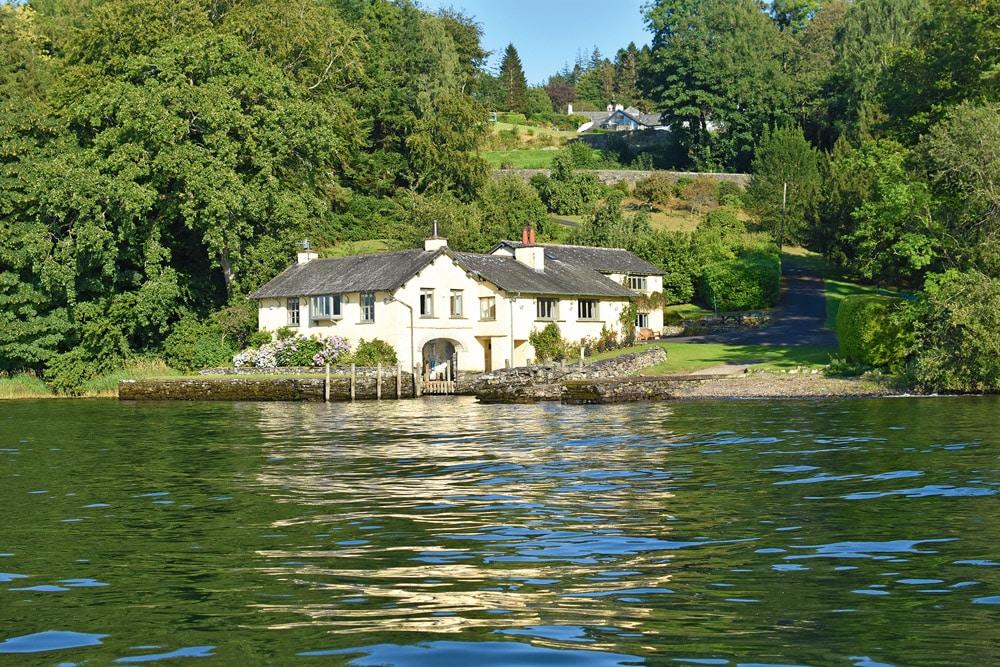
Houses on the lake shore range from ultra modern to picture postcard
Bluebird waters
Lying parallel to Windermere in a north-south orientation, Coniston is just a half-hour drive away from Bowness. Although the inflated Kolibri 390 is well suited to being transported atop a vehicle’s roof bars, we decided to deflate it, roll it up and carry it in the boot of our car.
Upon arrival, we made our way to the car park at the Bluebird Café, located at the head of the lake. Although we had to pay for parking, no charge for launching is made here, and though shared with the lake’s hire boats, the wide and gently descending slipway offers a generous degree of space. So, with all haste, we pumped up the kayak and carried it with little effort to the slip. This was followed by the lightweight outboard, which, upon being lifted onto the transom and being secured via its clamp screws, meant we were ready to go. Simplicity at its best!
Clambering aboard, we looked at each other in trepidation over the prospect of ending up ‘in the drink’. By now, we were starting to attract the attention of a good few curious onlookers ashore too. However, to our relief and no doubt their disappointment, our little craft proved surprisingly stable. The day was looking promising …
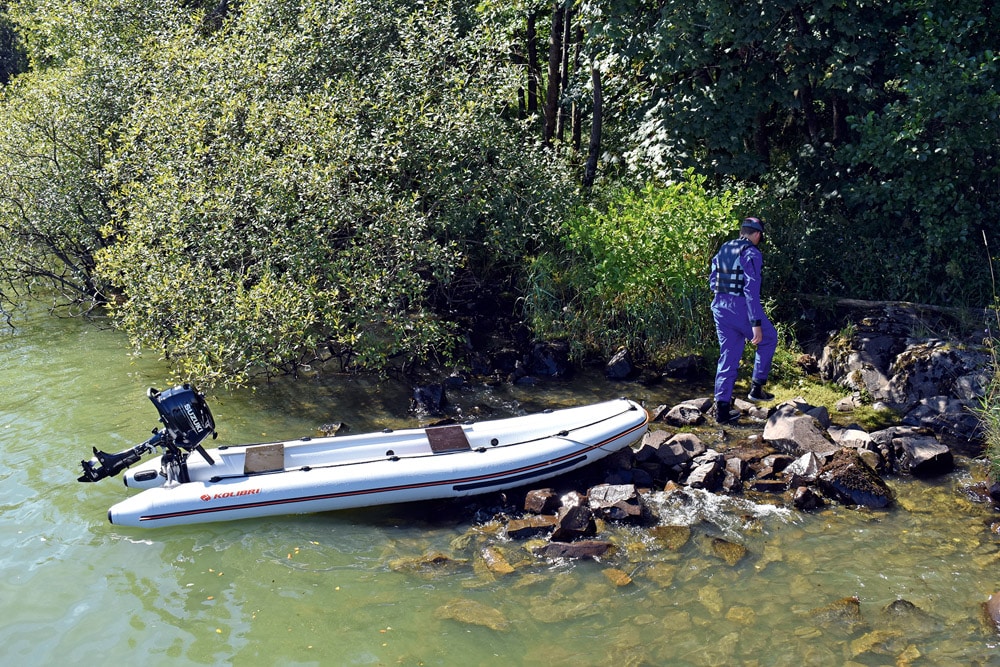
The 390 is perfect for exploring shorelines and islands
Despite Coniston being famous for its Power Boat Records Week (held at the beginning of November each year), and of course being the infamous site of Donald Campbell’s fatal high-speed Bluebird K7 crash, we found ourselves once again being bound by the same unilateral 10-knot speed limit.
Joining the many kayakers and paddleboarders out on the water that day, we began to familiarise ourselves with the Kolibri’s handling characteristics. This came together pretty quickly, but it was important to remember that we were aboard a kayak and not a regular inflatable or SIB. For instance, to maintain stability, it was important to position ourselves on opposite sides of the craft. Crossing the wake of a passing tour boat proved a little hairy and reaffirmed that this was a small craft primarily designed for sheltered waters. When Tom trialled the boat on his own, he experienced a fair amount of lateral instability at full throttle. Tightening up the steering friction, though, helped to keep things a little more settled and under control.
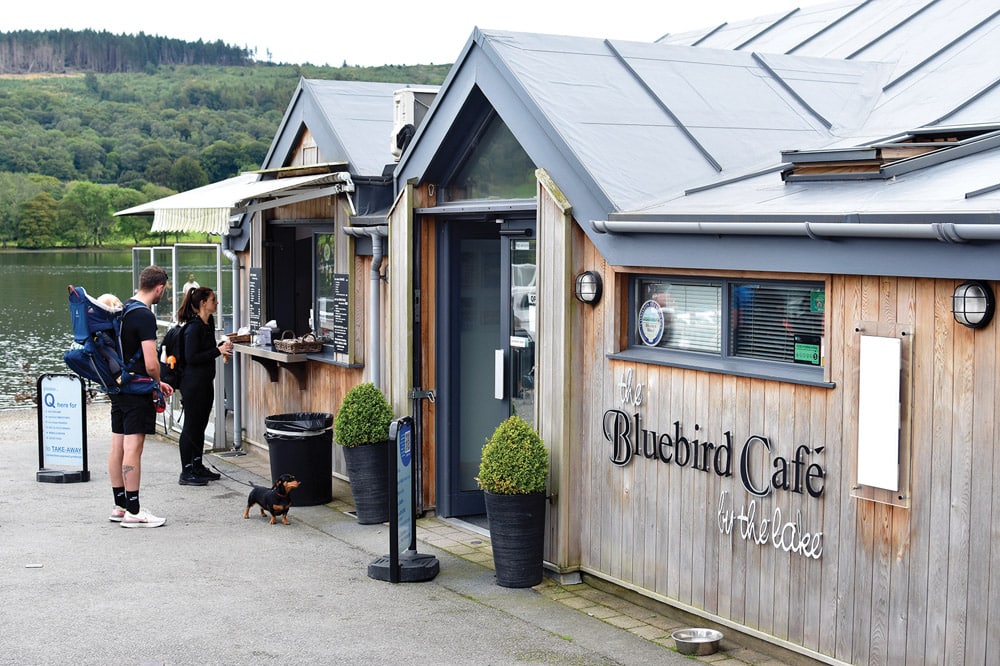
The waterside Bluebird Cafe.
Coniston Water is about 5 miles long and half a mile wide. Above its western shore, the fell of the Old Man of Coniston towers above the lake and village bearing its name. The lake is about half a mile down from the village, where you can hire boats and bikes from the Coniston Boating Centre. There are shops, pubs and places to eat in the village, and a range of guest houses and B&Bs, as well as holiday cottages. The remains of agricultural settlements from the Bronze Age have been found near the shores of Coniston Water, and the Romans mined copper from the fells above the lake’s dark waters. History abounds here – you can sense it. In the 13th and 14th centuries, Coniston Water was an important source of fish for the monks of Furness Abbey, who owned the lake and much of the surrounding land. Later, from the days of the great Industrial Revolution, which depended upon the raw wealth of much of the north of England, copper mining, though detrimental to the watercourses, continued in this area until well into the 19th century.
Coniston has inspired many great writers too, which is perhaps not surprising when you witness its beauty, particularly from the water as we had the privilege. One of the best-known and most-loved writers, Arthur Ransome, set his children’s novel Swallows and Amazons along with the sequels Swallowdale, Winter Holiday, Pigeon Post and The Picts and the Martyrs around a fictional lake derived from a combination of Coniston Water and Windermere. Indeed, some of Coniston Water’s islands and other local landmarks can be identified in these novels. In particular, the books’ Wild Cat Island and its secret harbour are based on Coniston’s own Peel Island. The ‘Amazon River’ likewise is based on Coniston’s River Crake. If you have watched the 2016 movie adaptation of Swallows and Amazons, you will have seen many of the sights Tom and I had the pleasure of witnessing on the occasion of our visit. If you visit too, I can guarantee you will not fail to be impressed by Coniston’s wild Cumbrian beauty and wistful timelessness. Like Windermere and Ullswater, this lake’s captivating calm is irresistible, and its beauty undeniable.
Upon reflection
As we headed home, Tom and I chatted over our shared experience and agreed on the following conclusions. If you want a location that offers most of everything the lakes have to offer, then head for Windermere. But be prepared for the hustle and bustle of lakeside life and the many leisure craft you’ll encounter. If a large expanse of open water holds particular appeal and exploration is high on your list of priorities, then head for Ullswater. It may have less choice in the way of eateries and accommodation than the former, but in terms of breathtaking scenery, Ullswater really does take the crown in our view. Then finally, if you want to get afloat simply and affordably, and experience an undeniable degree of nostalgia and history, mark Coniston as your waypoint. One word of warning, though, regarding all three lakes: none of them have dockside fuel. Be prepared with portable tanks as you will need to source any fuel your stay may require from the local petrol stations.
Freshwater lake adventuring certainly does offer a refreshing change from coastal boating. We really enjoyed our three-lake experience and would wholly recommend this form of boating, whether this be from the standpoint of supplementing your existing boating activities or as a pastime in its own right.
Kolibri 390 motorised kayak
The 390’s strength is that it hasn’t suffered from being ‘overengineered’. Under the bow there is a chunky D-ring, large enough to be used as a lifting handle. The floor is fully inflatable but flat-bottomed in design and so does not possess any kind of vee to mimic the profile of a keel. Bridging the tubes are two composite thwart-styled seats. These are fitted in such a way that they can slide fore and aft to suit. At the rear is the all-important transom. This is raised towards the centre in order to set the correct engine height. Either side, fitted to the inner faces of the extended tubes, are two moulded plastic carrying handles. Although a little tight for my chunky hands, I still found them to be a very useful addition. Nevertheless, it could just be that the Kolibri has the ability to bridge the gap between the paddleboard and the inflatable tender market.
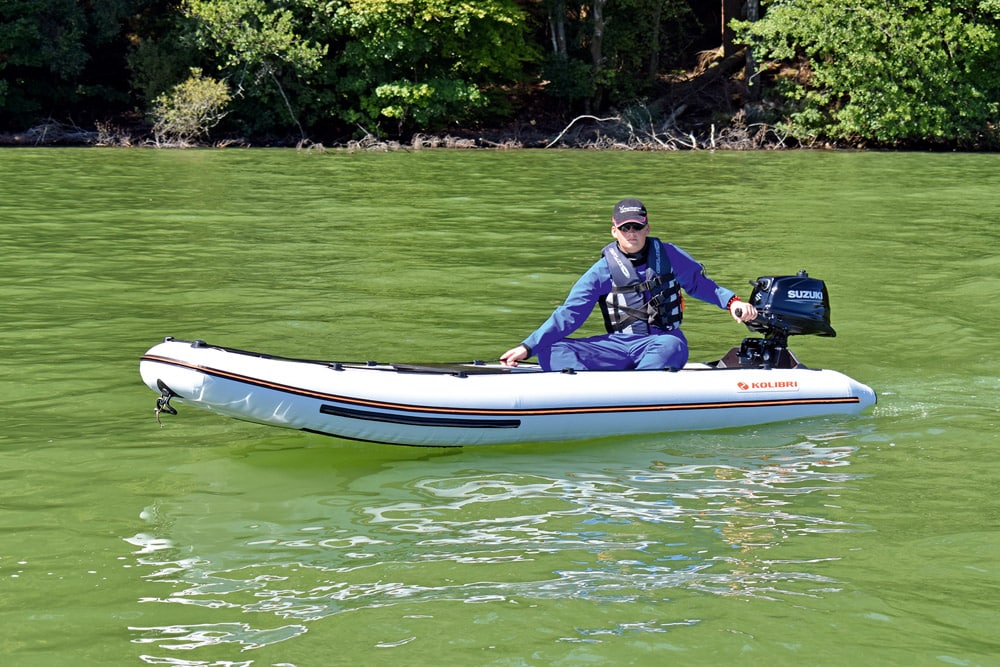
The lack of keel leads to directional instability under power. Tightening the steering friction helped to control this.
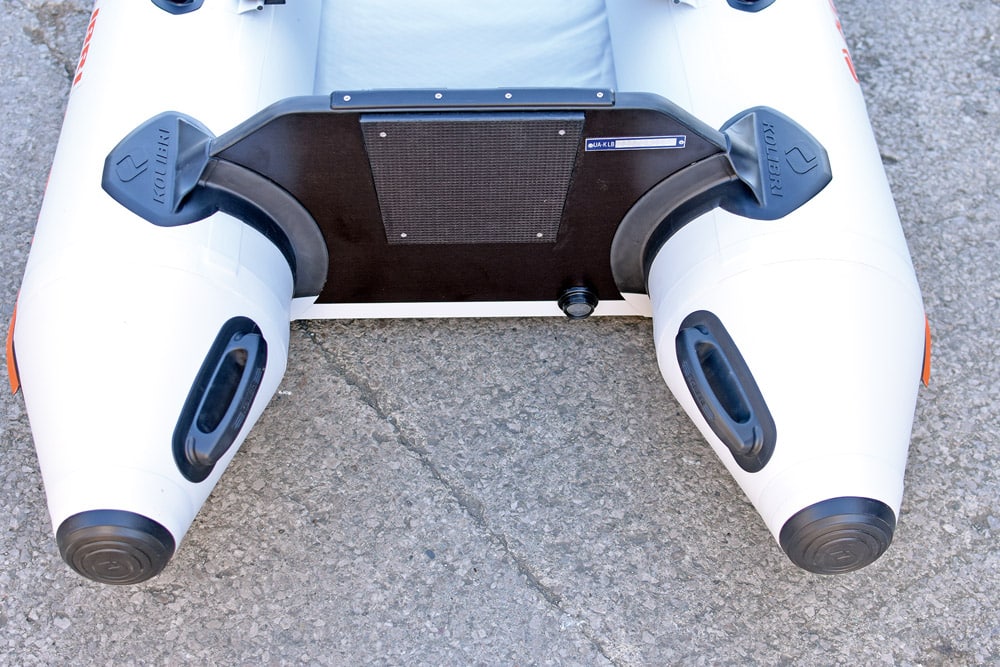
Inboard carrying handles and a ‘proper’ transom are well thought out.
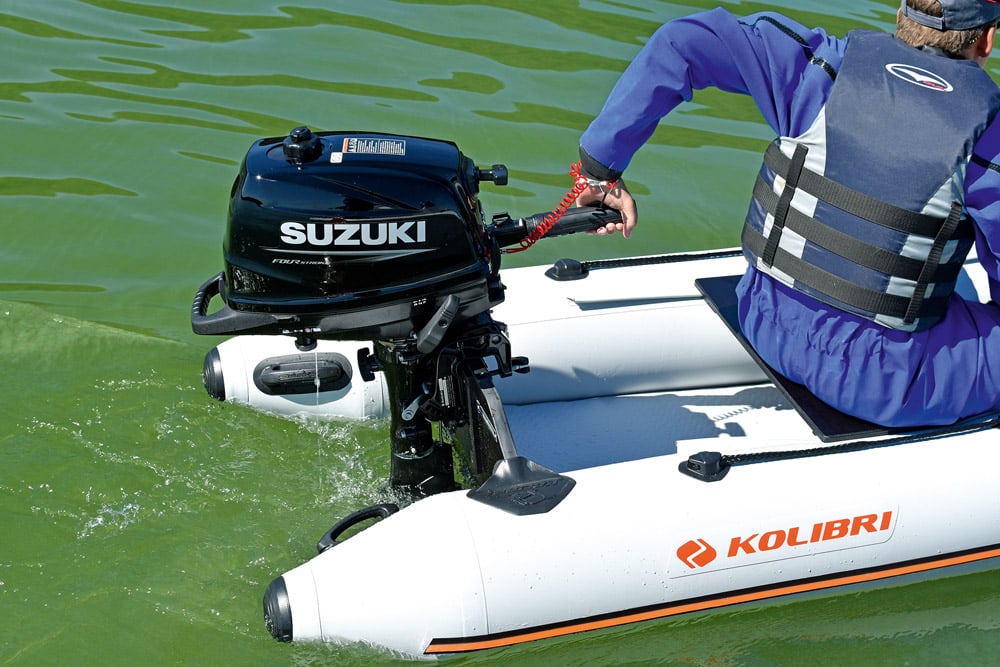
5hp Suzuki gives sprightly performance whilst the integral fuel tank leaves the kayak uncluttered.
The featured boats
Smartwave SW4200 CC

- Construction: Roto-moulded MDPE (medium density polyethylene) hull filled with Endurathane foam
- Prices start from: £16,995 (inc. VAT) with Suzuki DF25 ATL
- Price as tested with Suzuki DF40 ATL: £18,215 (inc. VAT)
- Capacity: 5 people
- Length: 430cm
- Beam: 193cm
- Max HP: 50hp
- Hull thickness: 10mm
Brig Eagle 6H Custom

- Prices start from: £41,500 (inc. VAT) with Suzuki DF100 BTL
- Price as tested with Suzuki DF140 BGTL: £49,755 (inc. VAT)
- Capacity: 10 people
- Length: 600cm
- Beam: 240cm
- Tube diameter: 51cm
- Chambers: 5
- Max HP: 150hp
- Load capacity: 1125kg
- Dry weight: 550kg
- Weight with max engine & fuel: 808kg
- Fuel tank: 121L (built in)
- Freshwater tank: 39L
Kolibri Travel Series KM-390C inflatable canoe
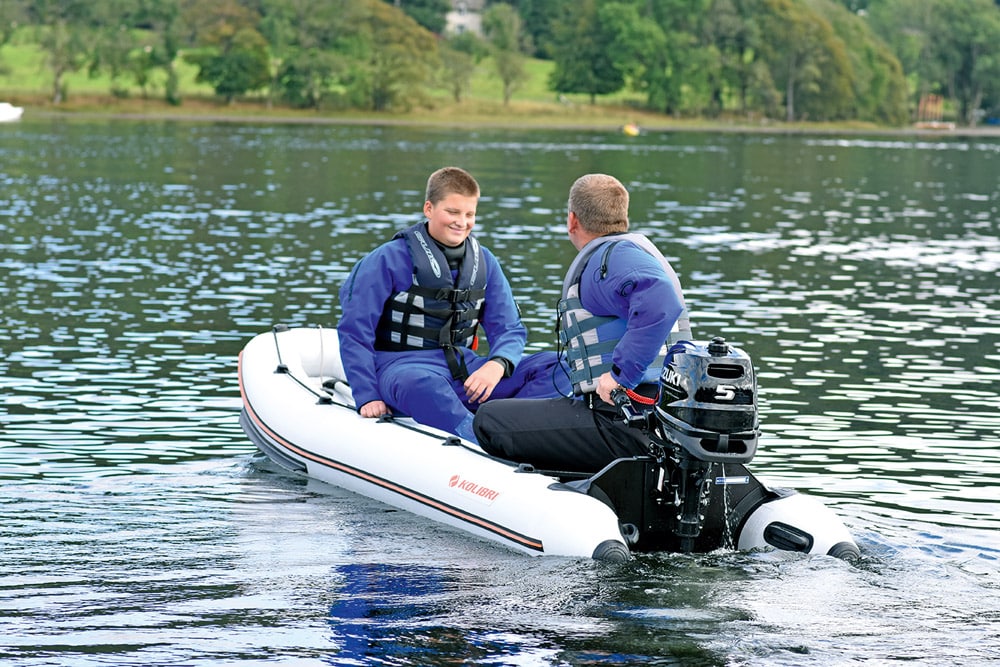
- Engine tested: FourStroke outboard – £1,275 (inc. VAT)
- Price as tested with Suzuki DF5 AS OBM: £2,195 (inc. VAT)
- Capacity: 3 people
- Length: 390cm
- Beam: 104cm
- Max HP: 6hp
- Tube diameter: 32cm
- Chambers: 4
- Load capacity: 380kg
- Weight: 25.85kg
- Packed dimensions: 90 х 66 х 47 cm
Coniston Facts
- The lake was formerly known as ‘Thurston Water’, a name derived from the Old Norse personal name ‘Thursteinn’ + Old English ‘waeter’. This name was used as an alternative to Coniston Water until the late 18th century.
- Oddly, Coniston is the third-largest lake by volume, though only the fifth largest by area, measuring 5 miles long and just half a mile wide.
- In 1939, Sir Malcolm Campbell set the world water speed record at 141.74mph in Blue Bird K4.
- In 1967, Sir Malcolm’s son Donald died at 320mph while attempting to set the latest of many previous records he had set. The wreckage was eventually recovered in October 2000, and Campbell’s remains were recovered in May 2001.
- For real-ale fans, we would recommend sampling ‘Bluebird Bitter’ – a local ale produced by Coniston’s very own brewery.
Windermere local knowledge
If you want to launch your own boat on Windermere, you are best heading for the public slipway at Ferry Nab LA23 3JH: lake.wardens@southlakeland.gov.uk
- Parking fee for car and trailer: £13.50
- Launching free for powered, trailered craft: £14 (unpowered, hand-carried craft are free)
- Registration number boards (pair): £16
- Lake map: £5.25
- Registration costs £20 and needs to be done online and in advance via lakedistrict.gov.uk
- Fuel: although diesel is available by appointment at Windermere Marina Village, there is no petrol available on the lake, so be sure to bring plenty with you.


